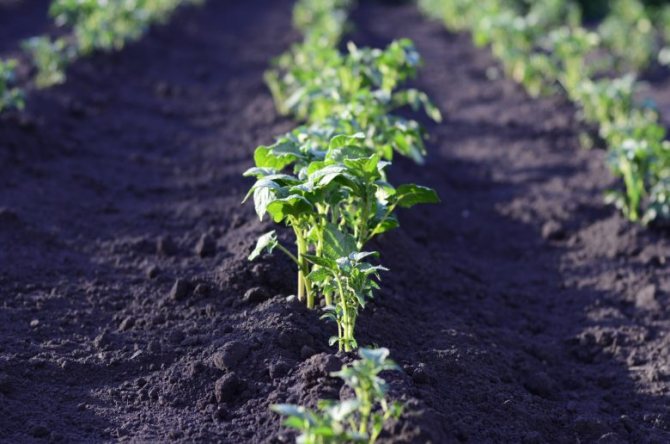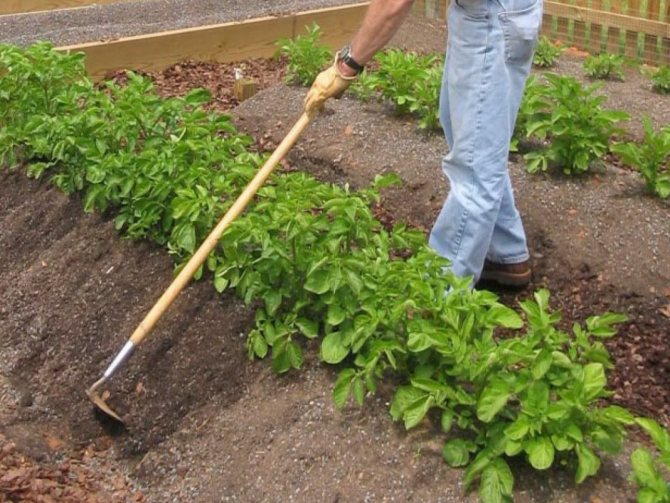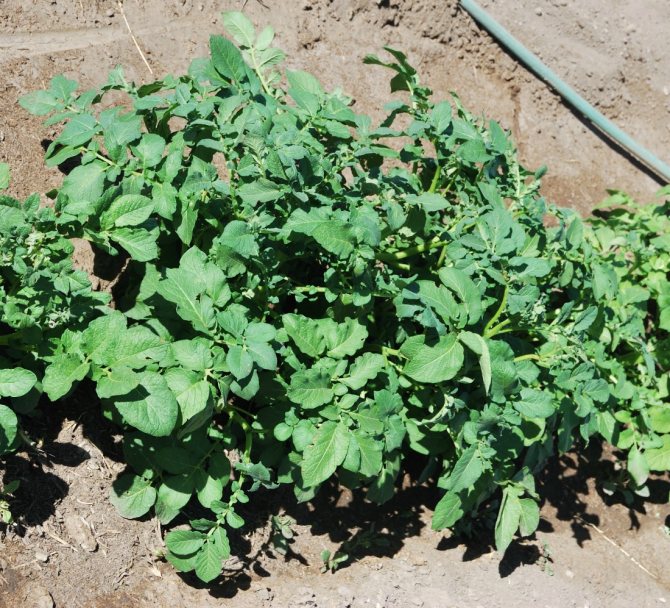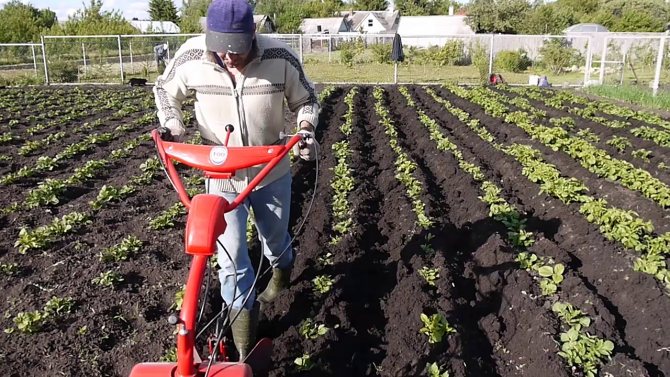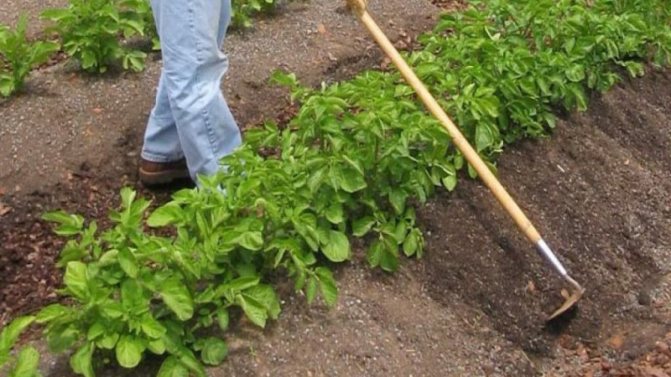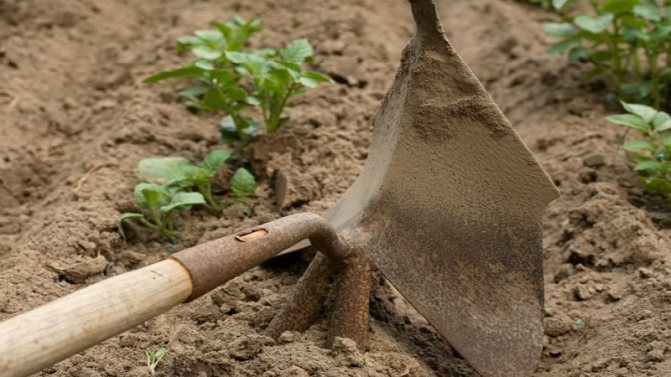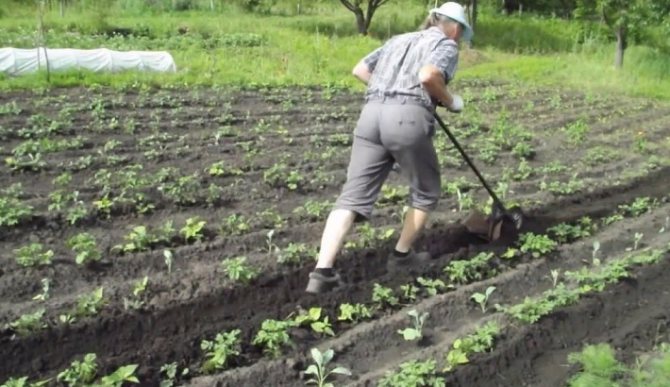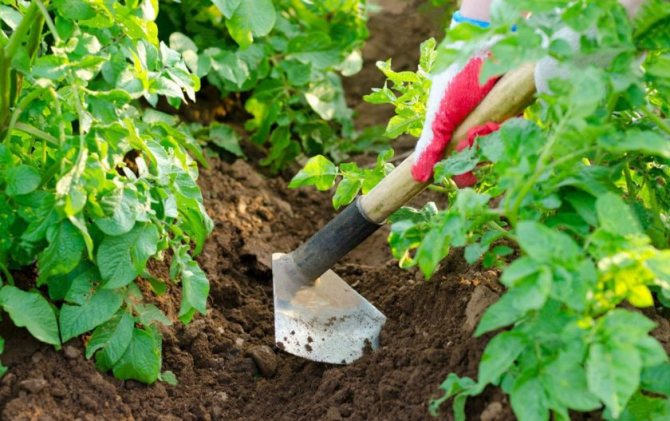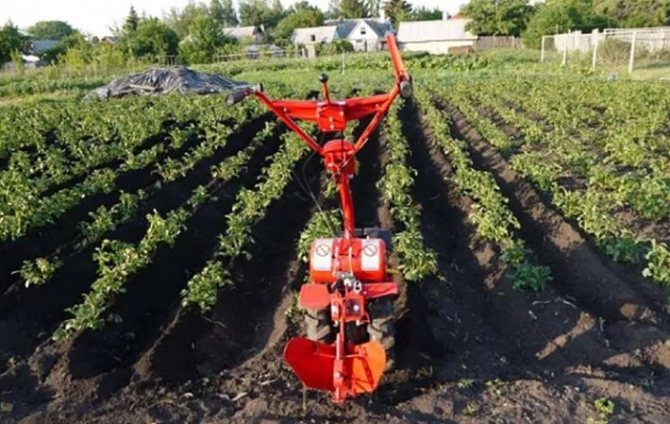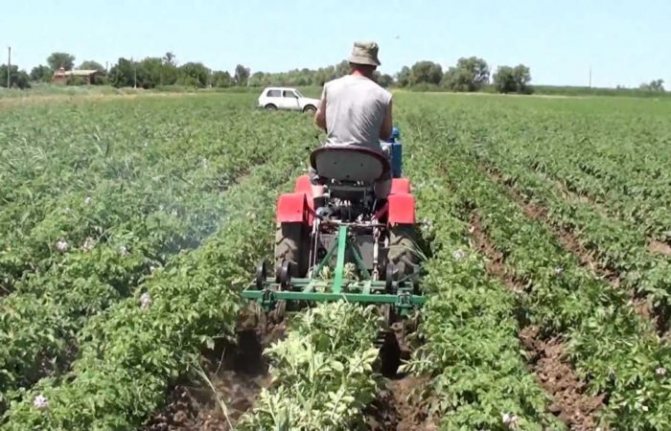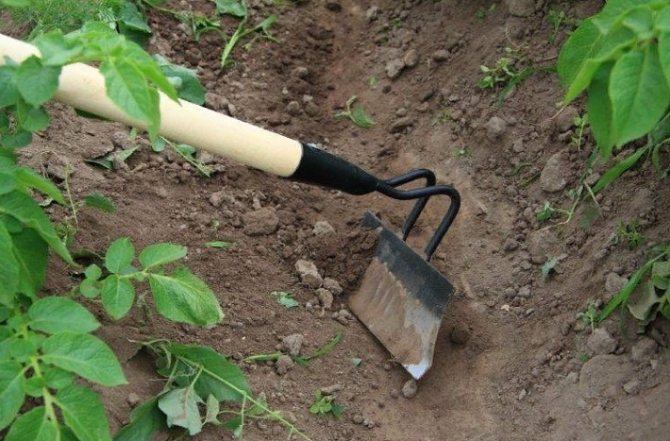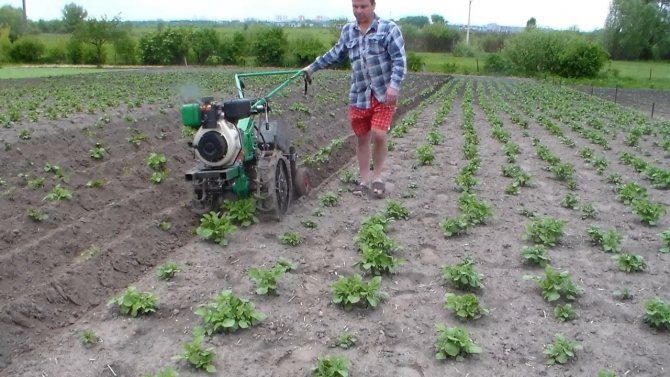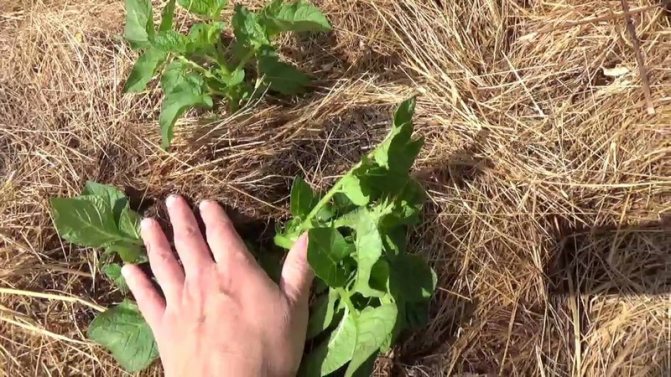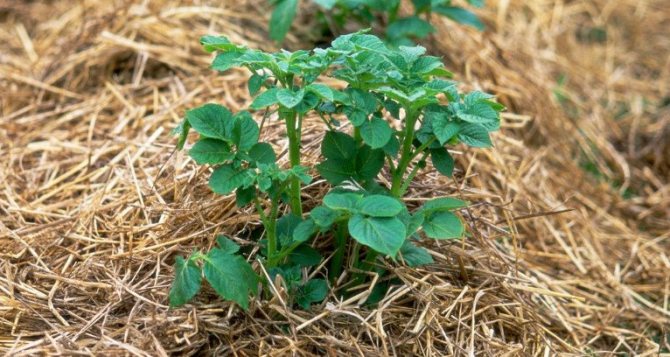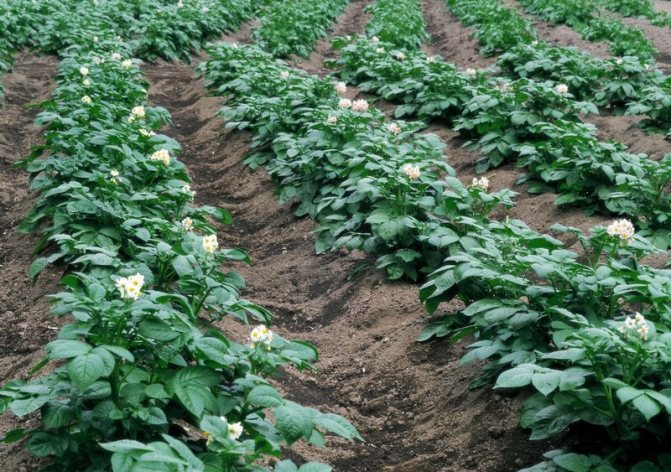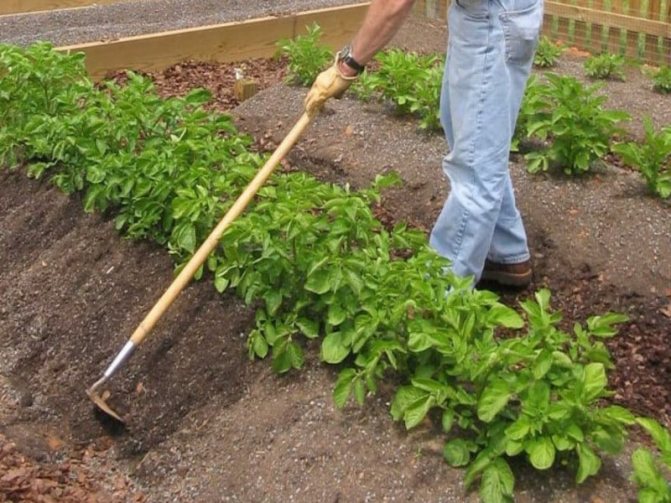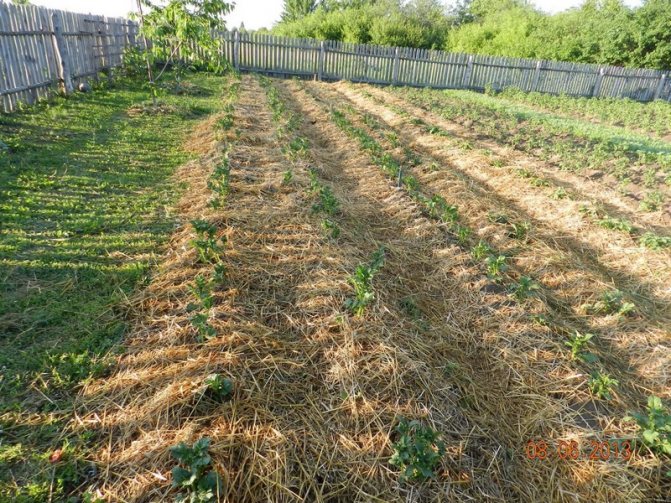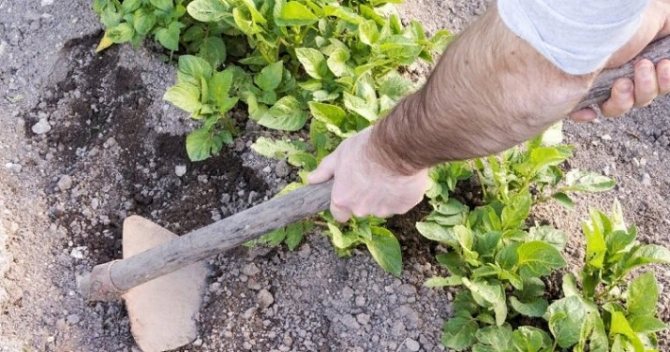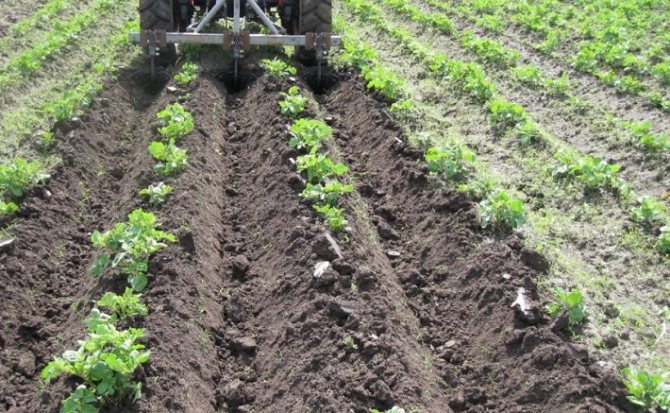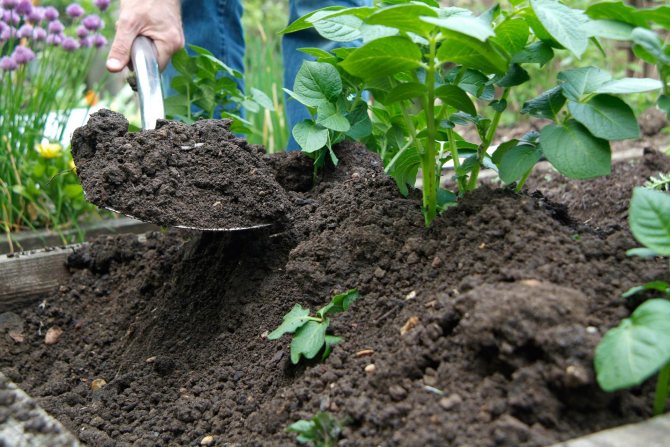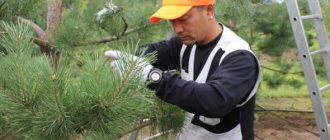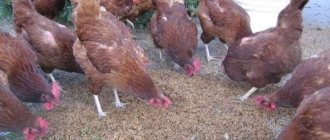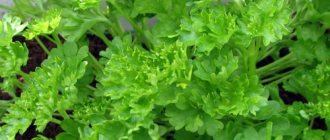Summer is coming - the time of the hardest work in the garden comes - weeding, hilling potatoes. It seems to be nothing special ... Arm yourself with a hoe and go ahead - fight for a good harvest! Gardeners know that this is quite hard work. So it is necessary or not necessary to spud potatoes, what are the terms, at what time should it be done? Why are we doing this? How is it correct? What is the height of the ridge? Is it possible to do without hilling?
From the experience of my parents, from my own experience, the experience of others, I can say - it is impossible. Experts also assure that without hilling, you can lose 25-30% of the possible yield, in addition, loosening enriches the soil, and, consequently, the plant itself with oxygen. This is an important part of the potato growing process. By the way, the looser the soil, the more crumbly, the more tasty the potatoes will be.
What is hilling and why to do it
As soon as the first leaves appear on the surface, the potatoes need to be spud. To do this, you need to rake the earth to the bush in such a way that a kind of cone forms around it. This is done so that the plant develops a larger number of tubers, they become full and stronger.
Scientifically speaking, potatoes form underground stems called stolons. The tubers themselves are bulges at the ends of the stolons. They have one feature - they grow only in complete darkness. When exposed to light, chlorophyll is formed in them and they turn green. Hilling potatoes helps to ensure that the shoots do not crawl out of the soil, but remain under the soil layer. The purpose of the procedure is to stimulate the growth of stolons, and therefore tubers.
In addition, loosening enriches the soil, and, accordingly, the tubers with the necessary oxygen, ultimately hilling contributes to an increase in the yield of potatoes.
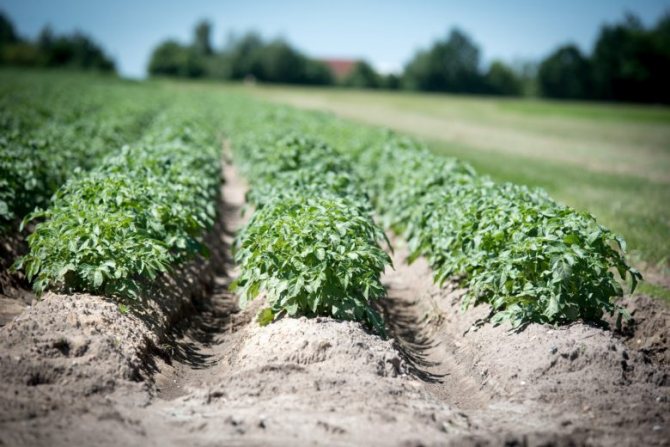
The traditional way is planting and hilling potatoes in rows
We figured out why the potatoes are spilled, but this procedure has its own nuances: when exactly to start it, how many times to spill per season and at what time it is preferable to do it.
When to huddle potatoes
It is difficult to name the exact dates, since they depend on the location in which your site is located, on the weather conditions and on which variety you have chosen. However, there are common periods in the development of this culture, which will be difficult to miss even for a novice summer resident.
You can start the first hilling after the first leaves appear. The bushes should be 7-10 cm tall. This will save the crop from recurrent frost and will help stimulate the growth of the root system. The second hilling can be started after 14 days, the third - after 30 days. If there is not enough time, the second procedure can be ignored. During the flowering period, such work should not be carried out - if you did not have time to do this before the buds open, do it after or do not carry out the procedure at all.
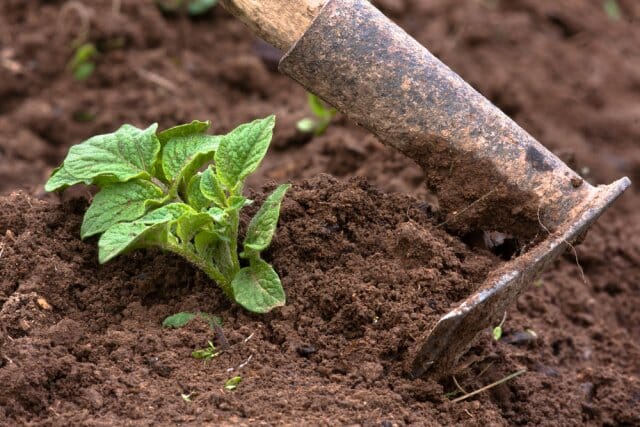

237
Optimal timing and quantity
I will try to explain how and when to sprinkle potatoes correctly.
First time hilling of potatoes is carried out when the first shoots appear on the soil surface. Thanks to this procedure, you can do two things at the same time: remove the emerging weeds and protect the plant from irreversible frosts.Frosts in some areas may appear in May or even early June, but potatoes can tolerate a drop in temperature quite easily. After hilling, rapid growth of potatoes is noted, its stem is poured and grows.
Second time hilling potatoes is carried out before flowers appear on the bushes. The flowering process suggests that tubers begin to form underground on the potato. To increase their number and correct formation, it is necessary to saturate the soil with oxygen, loosening it, and in order to avoid the appearance of tubers on the surface, you need to sprinkle them with earth, ensuring complete darkness.
Is it possible to huddle potatoes during flowering? After the potatoes have bloomed, any loosening must be canceled so as not to damage the nascent tubers.
Third hilling carried out when the tops grow.
On a note! If the bush falls apart, begins to grow in breadth or falls out of the common ridge, and at the same time turns the tubers out of the ground, hilling is necessary regardless of how much time has passed since the last hilling.
Usually, experienced gardeners feel the moment when they need to loosen the rows so that they continue to grow as evenly and beautifully. Some people loosen potatoes 4-5 times per season, breaking the crust.


When flowering, potatoes should not be spud
Advantages and disadvantages
Hilling is an environmentally friendly alternative to the use of herbicides in agriculture, which provides for the control of weeds throughout the entire cultivation period.
The main advantages of hilling potatoes:
- In the process of hilling, simultaneous loosening occurs, which improves soil aeration;
- Potatoes grow faster;
- In parallel, weeds are destroyed;
- The level of moisture in the soil rises, root crops are protected from drying out;
- The growth of stolons is actively stimulated, on which the formation of tubers occurs;
- The compact growth of potato bushes is ensured. Plants do not obscure each other in the beds, and receive uniform illumination.
Correct hilling technology
If we talk about the observations and habits of avid summer residents, they advise:
- do not huddle in the heat, since from manipulating the soil, against a background of high temperature, the plant can wither;
- try loosen up after rain;
- when hilling, you can weed a crop... In this case, the weeds do not need to be chopped at the root, it is better to pull it out;
- need to choose handy tool, which will be convenient both in the length of the handle and in the type of nozzle;
- before hilling, you can root top dressing: For 10 liters of water, take 20 grams. ammonium nitrate and potassium sulfate. Pour the resulting solution into 1 sq. M. potato ridge.
Better to take up the hoe in the morning or evening hours. Try to pick a day after the rain. Loosening wet soil will remove the crust on the surface and enrich the tubers with sufficient moisture and oxygen.
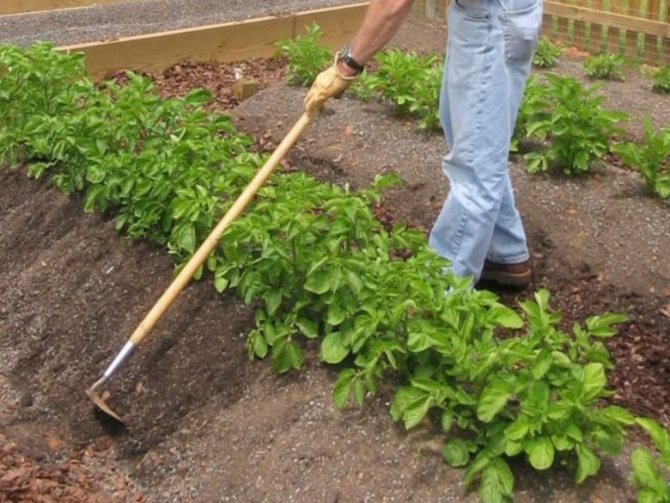

Hilling with a hoe is one of the oldest ways to care for potatoes
It is better to avoid sprinkling with dry earth. But if the year is dry, then it is better to hoe than to leave it as it is.
When and how this agricultural technique is used
- The first hilling is carried out when green shoots grow to a height of 8-10 cm. The second is before flowering, i.e. after about 2-3 weeks from the first. If necessary, spud a third time, when the height of the shoots reaches 25-30 cm.
- Hilling is carried out only on moist soil after rain or watering, preferably in the evening, when the daytime heat gradually subsides.
- An agrotechnical technique can be made using a hiller, a walk-behind tractor, or manually using a hoe. The use of a hoe is advisable for small quantities of bushes, since the process is energy-intensive and takes a long time.
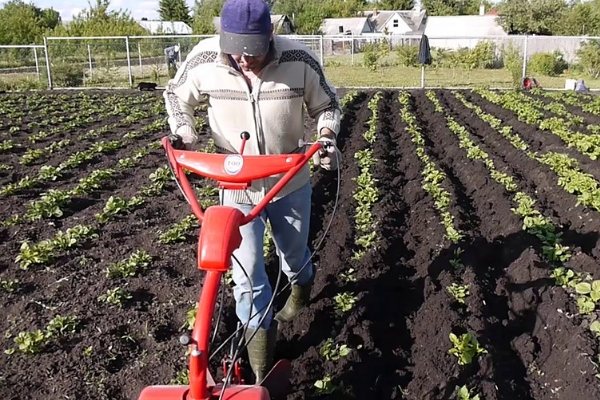

The question of hilling is still open to discussion in agricultural circles. However, this technique has proven its feasibility in the northern regions of the country, and with the right approach to it, it can significantly increase the yield of potato plantings.
If you find an error, please select a piece of text and press Ctrl + Enter.
We tried to write the best article. If you liked it, please share it with your friends or leave your comment below. Thank you! Excellent article 2
Hilling methods
The second bread took root in Russia back in the 18th century. People were looking for different ways to develop new varieties, properly care for the crop, as well as get better yields.
In this regard, various systems of potato care have developed. In addition to the usual hilling from the aisle to the bush, there are other options for carrying out this procedure. All methods of hilling potatoes have found their application.
Fanny
The classic way is to scoop up the earth to the entire bush as a whole, as if collecting it into a bouquet. Fan hilling (or, more correctly, uncoiling) is carried out in the following way: each stem of a plant is retracted to the side, separately loosened and repaired with hay or grass. It is believed that with the isolation of the stems, the yield increases.
Fan hilling is carried out when the potato grows about 15 cm and more. They are sprinkled with earth, grass or plants, which are planted next to them for their subsequent embedding in the soil (scientifically speaking - siderates).
The stems are laid out in a circle from the center, which is why this method got its name for its similarity to a fan. In this position, the stems give new roots and form tubers.
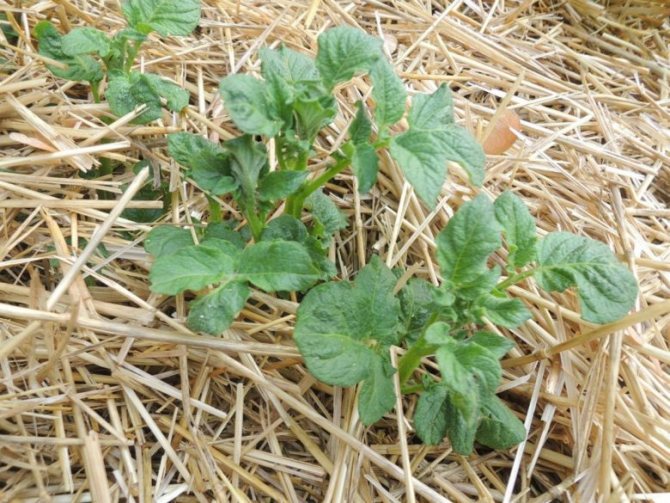

The method of growing potatoes under mulch came from Finland
Those who use this method note that if the procedure is carried out correctly, the yield will be higher than when sprinkled with earth.
The blind
The first hilling is carried out when the leaves rise 15 cm.But when blind hilling no seedlings are visible above the ground. With this method, the second procedure is carried out when the potatoes have just emerged from the ground.
Stolons (shoots on which tubers are formed) become white when blindly hilling. It is on the white part of the stem that most of the crop is formed.
But, naturally, when cultivating potatoes in a blind way, there is a high probability that the shoots will be touched by the sharp knife of the tool.
Grass
This method migrated to Russian gardens from Finland. Here they use mowed grass - mulch as a powder. Straw can be used as mulch.
- The tubers are planted in the ground in such a way that the sprouts are almost at the very surface of the earth.
- When they start to grow, they need to be sprinkled with a layer of grass. Then, as the stems grow, you need to lay more layers of grass.
- When they reach a height of about twenty centimeters, you can allow the stems to crawl to the surface.
Hilling potatoes with grass
You can take any grass: mow it on purpose, or use plucked weeds.
Gardeners using this hilling method note not only an increase in the yield, but also the absence of scab on the tubers.
When hilling in this way, you need to ensure that the tubers do not show up from the soil, otherwise they will turn green and be unusable.
Hilling tools
Hilling is carried out both manually and mechanically.
Some gardeners, whose potatoes are planted in small areas, are used to using hand tools: a shovel, a hoe, a hoe. Those who need the result faster can buy or make a simple disk unit themselves.
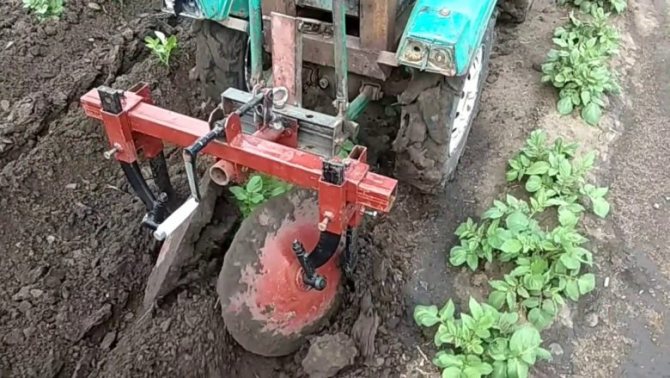

The disc hiller can be designed by yourself
The third option for those people who love innovations and wonders of technology is to purchase a walk-behind tractor.He will help in plowing the area for any planting.
Chopper, shovel, hoe
Hilling with hand tools is the most ancient method that requires physical training and a certain skill, because to pick correctly is not easy.
All these devices consist of a handle and a metal attachment. They work with these tools as follows: first you need to rake the earth from the aisle to the potato trunk on one side, and then on the other. At the end of each row, embankments must be made. This is to keep moisture between the rows.
These tools can be purchased from specialized stores. Many people make them themselves, choosing a cutting suitable for grasping and growing and planting the necessary nozzle on it. It is better to have all three of these tools on the farm at the same time.
Motoblock
This unit is indispensable for plowing a plot. It can also be used in other agricultural activities, such as hilling. To do this, special attachments are attached to the walk-behind tractor. These attachments are not included with all models of walk-behind tractors, they need to be purchased separately. Install 2 rippers in the front and one hiller in the back.
For hilling potatoes with a walk-behind tractor, you must have a keen eye, the distance between the rows must be strictly the same. If the bushes sit unevenly, then there is the possibility of injury to the tubers.
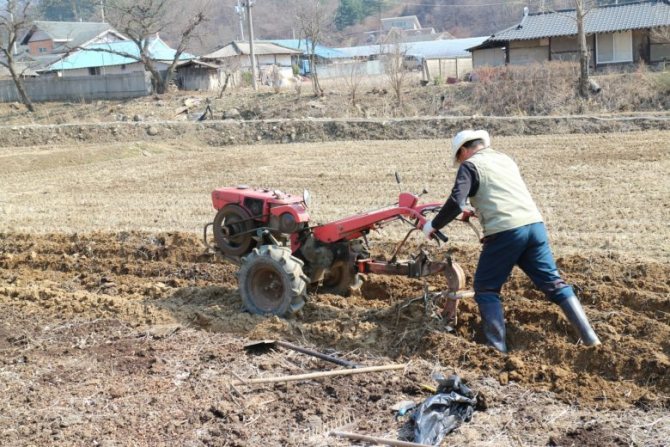

The walk-behind tractor can be equipped with special attachments
Now there is a huge selection of motoblocks for different wallets. There is an opportunity to purchase suspension elements. The disadvantage of buying a walk-behind tractor is its payback. Using the unit for several tens of thousands of rubles is incommensurate with the cost of vegetables grown.
Hand plow
The oldest hilling tool. This unit consists of a frame to which the pruning knife, wheel and linkage are attached. Many people construct it with their own hands. With the help of a hand plow, you can go in one pass along the aisle, while hilling the sides of adjacent rows.
He can be pulled by both a horse and a man. For easier hilling, it is better to choose a lighter machine.
Now plows are used together with walk-behind tractors, which significantly speeds up the hilling process.
Disc hiller
The hiller is very helpful in the care of agricultural crops. In addition to potatoes, you can spud other vegetables with them: beets, carrots, etc.
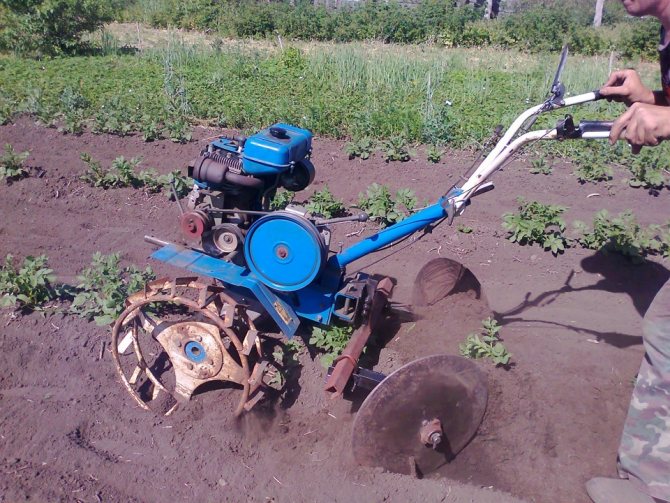

Motoblock with disc hiller
Disc hillers are divided into:
- propeller;
- disk;
- listerous;
- with different coverage widths.
This device is a good helper at the summer cottage. With its help, they make even furrows when planting vegetables, which subsequently allows them to be piled up just as smoothly. In everyday life, they usually use lister models of hillers, and even make them themselves.
Hillers are of two types:
- with adjustable length and width of capture;
- static, unregulated units.
Non-adjustable models have symmetrically located discs that are installed at a certain angle relative to the main axis, so they cannot be switched to a narrower stroke.
Riggers that have an adjustment function can usually be switched to the desired stroke width, as well as set the angle of inclination of the discs.
In addition, in terms of their functionality, these units are also divided into
- single row (consisting of one plate),
- double row (they have two plates, they can process the culture from both sides at once).
Do-it-yourself hiller
The disc hiller can be made by yourself. This requires:
- steel sheet (about 3 millimeters),
- racks,
- T-shaped leash,
- mounting bolts,
- screw talers,
- locking elements,
- washers,
- disks.
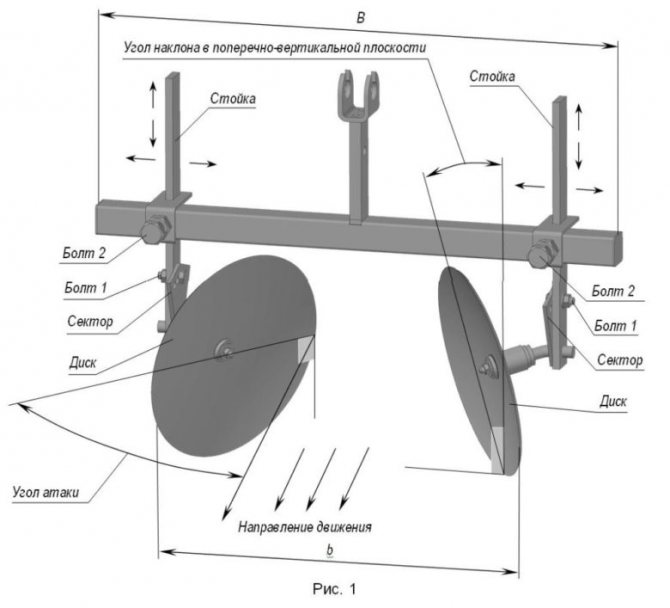

drawing for disc hiller
Before you start making a structure, it must be presented visually. It is necessary to draw the future hiller and make all the calculations.Think over all the bends of the arcs, the inclination of the discs, the possibility of installing other elements to expand the functionality. For example, in order to use the hiller in digging and harvesting, you can install a special tip on it.
On a note! After the drawing is drawn, it is necessary to transfer it to the volumetric figure. It can be made from cardboard. At this stage, it will be clear if there were any errors in the calculations.
Then you need to carve out the model from steel. Bend the workpieces until the outside is parallel with the radius line.
Next, we fix the elements together by welding. Welding seams must be processed with a grinder.
The post, T-bar and screw talers should be bolted in a T-shape and connected to the main structure.
Disc wheels are connected by adapters and adjusted. Then they are bolted to the hiller itself.
In order for the device to function normally, it is necessary to monitor the surface of the discs: so that they are always sharpened and have no chipping.
Homemade disc hiller for a walk-behind tractor
Automatic or mechanical cultivator
Small motor vehicles are an indispensable assistant for summer residents. It includes:
- hand cultivators;
- electrical;
- motor cultivators.
Hand models consist of gear wheels that are attached to a long handle. This unit is convenient for weeding: the toothed discs catch and pull the weeds and roots. Loosening in this case is rather insignificant, because the hand cultivator should be buried only five centimeters into the soil. Thus, it cannot cope with larger weeds, which have a highly developed root system. Hilling potatoes implies deeper soil penetration, so it is better to consider other models as a hilling machine.
Electric cultivators have motors up to 1500 W. With these devices it is convenient to loosen the ground, weed between bushes, next to tree trunks. The inconvenience is the power supply of the cultivator from the network: do not go further, you constantly need to monitor the cord that crushes other plants on the site.
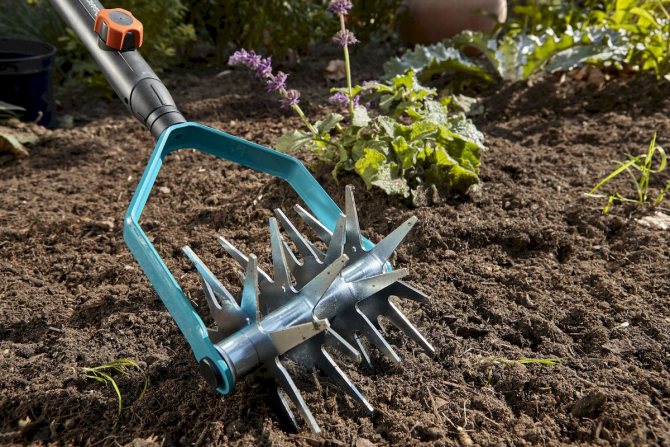

Hand cultivator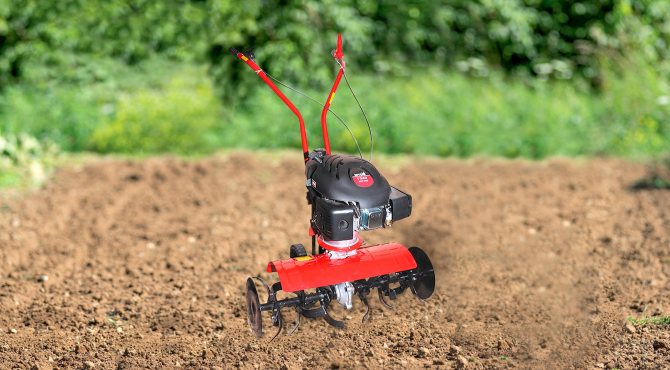

Electric cultivator
Motor cultivator - a universal device, with its help you can perform various agrotechnical works: plowing, cutting grass and weeding. Some models can accommodate a trolley for the transport of goods up to two hundred kilograms.
The motor-cultivator is suitable for hilling potatoes: it has a good grip; in view of lightness, it is suitable even for women.
The choice of these devices is now very large, you can find a model to your taste and needs.
How to properly spud potatoes with a walk-behind tractor
Is it possible to grow potatoes without hilling
Man has always tried to optimize certain processes and work. Experiments to facilitate agronomic work and the cultivation of potatoes were not spared.
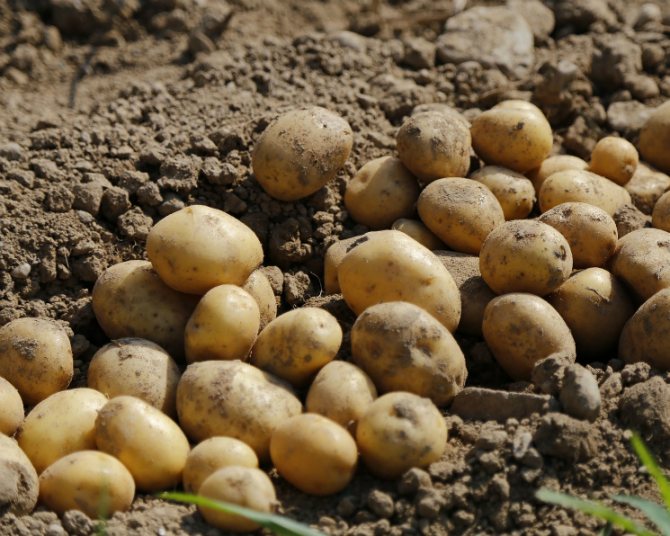

Summer residents celebrate a larger harvest with a boring method
Traditionally, summer residents still prefer the usual hilling, fearing the so-called "poke method". Other gardeners with inquisitive minds, accustomed to conducting experiments on their plots, are trying other methods of caring for plants, for example, for potatoes, come up with new ways of planting it:
- under the black non-woven fabric;
- in isolated ridges or containers;
- in bags.
An alternative to hilling is the method of unrolling potatoes. It is carried out as follows: each stem of a grown plant is taken to the side and covered with earth, straw or grass.
For the same purposes, green manure and special agrofibre are used. At the same time, the potato grows in breadth, and not upward. During the entire growing season, mulch is poured onto the plant, and at the end of the season, the resulting nest is dug up.
The main plus of getting bored - weeds do not grow in the nests.The second plus is the very absence of hilling, there is no need to apply physical effort several times per season.
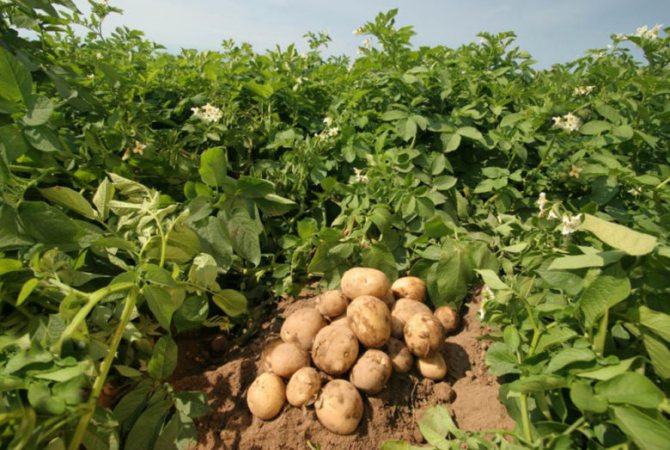

For a bezel-less method, you need to prepare the soil in the fall.
The disadvantages of this procedure include the cost of straw and mowing grass for mulch.
But you still have to work before taking the unwillingness. In order to grow a good harvest, you need to fertilize the soil in the fall:
- remove weeds on the site;
- in order to protect potatoes from the Colorado potato beetle and other pests, onion husks can be scattered over the soil surface before digging;
- the area where the potatoes will be planted must be dug up without breaking large stones;
- apply fertilizer from ash and 15 grams of urea per 1 square meter;
- the plot is re-covered with a layer of hay, and manure can be spread on top.
Before planting potatoes in the spring, rake the layer laid in the fall so that the soil warms up. Then level the mulch over the entire plot, forming ridges in which the tubers will be planted.
Watering the ridges is necessary only if there is a severe drought. To do this, pour a bucket of water per square meter. If it rains, then watering should be skipped - the top layer that covers the potatoes retains moisture very well.
On a note! If you systematically water the potatoes, there is a risk of rot or phytophthora on the tubers.
Various dressings when growing potatoes in a beetless way can be skipped. Due to the fact that fertilizers were applied to the soil in the fall, the mulch already contains all the necessary trace elements for good plant growth.
Hilling: how many times per season and how to hilling
In what cases is hilling not applied?
Inventive summer residents have adapted to growing potatoes in old tires, bags, and in such cases, hilling is not carried out. It is not necessary even when growing potatoes under a film cover.
Potatoes are also grown in a trench manner. When preparing a planting site, soil is removed from the trench, which is combined with organic fertilizers and returned to its place. After planting, some of the soil will not fit into the trench, and it is left next to the subsequent use for hilling. But when the soil is over, it is not necessary to intensively loosen the aisles so as not to harm the plants.


